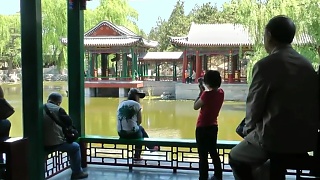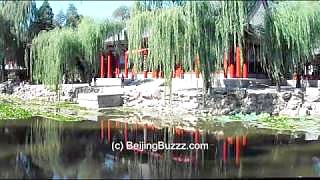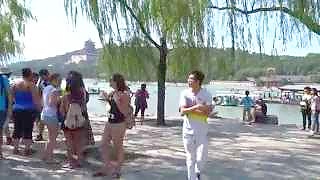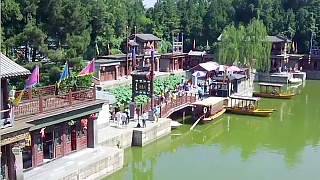
|
Introduction
China's traditional arts and crafts reflect its rich cultural heritage and diverse ethnic backgrounds. These art forms have been passed down through generations, showcasing exquisite craftsmanship and profound cultural significance. Here are the top 50 traditional Chinese arts and crafts, along with their origins and associated ethnicities.
1. Chinese Calligraphy (书法, Shūfǎ)
Origin: Han Dynasty
Ethnicity: Han
Chinese calligraphy is the art of writing Chinese characters with a brush and ink. It is highly regarded for its aesthetic qualities and expressive potential.
2. Chinese Painting (国画, Guóhuà)
Origin: Neolithic Period
Ethnicity: Han
Traditional Chinese painting involves brushwork on paper or silk, depicting landscapes, flowers, birds, and human figures.
3. Cloisonné (景泰蓝, Jǐngtàilán)
Origin: Yuan Dynasty
Ethnicity: Han
Cloisonné is an ancient technique for decorating metalwork objects with enamel, featuring intricate patterns and vibrant colors.
4. Chinese Embroidery (刺绣, Cìxiù)
Origin: Zhou Dynasty
Ethnicity: Han, Miao, Yi, Zhuang
Chinese embroidery is a decorative art that involves stitching intricate patterns onto fabrics using silk or cotton threads.
5. Paper Cutting (剪纸, Jiǎnzhǐ)
Origin: Han Dynasty
Ethnicity: Han
Paper cutting is a folk art where designs are cut into paper, traditionally used for window decorations and festival celebrations.
6. Porcelain (瓷器, Cíqì)
Origin: Shang Dynasty
Ethnicity: Han
Chinese porcelain, known for its delicate beauty and durability, has been highly prized for centuries and is often decorated with intricate designs.
7. Jade Carving (玉雕, Yùdiāo)
Origin: Neolithic Period
Ethnicity: Han
Jade carving is the art of shaping jade into ornaments, figurines, and ritual objects, revered for its beauty and spiritual significance.
8. Chinese Opera Masks (戏曲面具, Xìqǔ Miànjù)
Origin: Tang Dynasty
Ethnicity: Han
Opera masks are used in traditional Chinese theater to represent various characters and their traits through colors and patterns.
9. Silk Weaving (丝织, Sīzhī)
Origin: Shang Dynasty
Ethnicity: Han
Silk weaving is an ancient craft involving the production of silk fabric, known for its smooth texture and luxurious appearance.
10. Chinese Knotting (中国结, Zhōngguó Jié)
Origin: Tang and Song Dynasties
Ethnicity: Han
Chinese knotting is the art of creating decorative knots using a single length of cord, symbolizing good luck and prosperity.
11. Bronze Casting (青铜铸造, Qīngtóng Zhùzào)
Origin: Shang Dynasty
Ethnicity: Han
Bronze casting is an ancient method of creating bronze objects, including vessels, weapons, and ritual items, through mold casting.
12. Batik (蜡染, Làrǎn)
Origin: Han Dynasty
Ethnicity: Miao, Buyi
Batik is a traditional textile art involving wax-resist dyeing, creating intricate patterns on fabric, commonly practiced by the Miao and Buyi people.
13. Lacquerware (漆器, Qīqì)
Origin: Neolithic Period
Ethnicity: Han
Lacquerware involves coating objects with lacquer to create a hard, shiny surface, often decorated with intricate designs and inlays.
14. Bamboo Weaving (竹编, Zhúbiān)
Origin: Zhou Dynasty
Ethnicity: Han
Bamboo weaving is the craft of creating items like baskets, mats, and furniture using bamboo strips, valued for its durability and flexibility.
15. Chinese Puppetry (木偶戏, Mù'ǒuxì)
Origin: Han Dynasty
Ethnicity: Han
Chinese puppetry involves using hand-crafted puppets to perform traditional stories and plays, combining art, music, and storytelling.
16. Thangka Painting (唐卡, Tángkǎ)
Origin: 7th Century
Ethnicity: Tibetan
Thangka painting is a Tibetan Buddhist art form that involves creating religious images on cloth, used for meditation and teaching.
17. Pottery (陶器, Táoqì)
Origin: Neolithic Period
Ethnicity: Han
Pottery is one of the earliest forms of Chinese art, with hand-crafted ceramic vessels used for cooking, storage, and rituals.
18. Chinese Shadow Puppetry (皮影戏, Píyǐngxì)
Origin: Han Dynasty
Ethnicity: Han
Shadow puppetry involves manipulating flat puppets behind a screen to create shadows, telling stories with music and narration.
19. Rattan Weaving (藤编, Téngbiān)
Origin: Ancient Times
Ethnicity: Dai, Li
Rattan weaving is the craft of making furniture, baskets, and other items using rattan, commonly practiced by the Dai and Li ethnic groups.
20. Dough Figurines (面人, Miànrén)
Origin: Han Dynasty
Ethnicity: Han
Dough figurines are traditional folk art made from colored dough, sculpted into various characters, animals, and scenes.
21. Silver Jewelry Making (银饰, Yínshì)
Origin: Tang Dynasty
Ethnicity: Miao, Yi
Silver jewelry making involves crafting intricate silver ornaments, often worn during festivals and ceremonies by the Miao and Yi people.
22. Chinese Seal Carving (篆刻, Zhuànkè)
Origin: Zhou Dynasty
Ethnicity: Han
Seal carving is the art of engraving characters or designs onto stone or wood seals, used for stamping documents and artwork.
23. Tangka Embroidery (唐卡刺绣, Tángkǎ Cìxiù)
Origin: 7th Century
Ethnicity: Tibetan
Tangka embroidery combines traditional embroidery techniques with religious themes, creating elaborate and colorful textile art.
24. Peking Opera Costumes (京剧服装, Jīngjù Fúzhuāng)
Origin: Qing Dynasty
Ethnicity: Han
Peking Opera costumes are elaborate and symbolic garments worn by performers, representing different characters and social statuses.
25. Wooden Fish Carving (木鱼雕刻, Mùyú Diāokè)
Origin: Tang Dynasty
Ethnicity: Han
Wooden fish carving is a traditional craft involving the creation of wooden fish sculptures, often used in Buddhist temples as percussion instruments.
26. Tie-Dye (扎染, Zhārǎn)
Origin: Han Dynasty
Ethnicity: Bai
Tie-dye is a textile art practiced by the Bai people, involving the tying and dyeing of fabric to create intricate patterns and designs.
27. Paper Fans (纸扇, Zhǐshàn)
Origin: Han Dynasty
Ethnicity: Han
Paper fans are traditional hand-held fans made from paper and bamboo, often decorated with calligraphy and paintings.
28. Dragon and Lion Dance (舞龙舞狮, Wǔlóng Wǔshī)
Origin: Han Dynasty
Ethnicity: Han
The dragon and lion dance are traditional Chinese performances involving large, colorful costumes, performed during festivals to bring good luck.
29. Ethnic Costumes (民族服饰, Mínzú Fúshì)
Origin: Varies
Ethnicity: Various (e.g., Yi, Zhuang, Miao)
Ethnic costumes are traditional garments worn by various ethnic groups in China, each with distinct styles, colors, and patterns reflecting their culture.
30. Kesi Weaving (缂丝, Kēsī)
Origin: Tang Dynasty
Ethnicity: Han
Kesi weaving is a highly intricate form of silk tapestry weaving, creating detailed and colorful patterns often used for clothing and artwork.
31. Woodblock Printing (木版画, Mùbǎn Huà)
Origin: Tang Dynasty
Ethnicity: Han
Woodblock printing is a technique for printing text, images, and patterns, involving carving designs into wooden blocks and pressing them onto paper or fabric.
32. Shadow Play (皮影戏, Píyǐngxì)
Origin: Han Dynasty
Ethnicity: Han
Shadow play is a traditional form of storytelling using silhouetted figures manipulated behind a translucent screen, accompanied by music and narration.
33. Chinese Garden Design (中国园林, Zhōngguó Yuánlín)
Origin: Han Dynasty
Ethnicity: Han
Chinese garden design is the art of creating harmonious landscapes that combine natural elements like rocks, water, and plants with architecture and art.
34. Miao Silver Jewelry (苗银, Miáo Yín)
Origin: Qing Dynasty
Ethnicity: Miao
Miao silver jewelry is known for its intricate designs and craftsmanship, often worn during festivals and ceremonies by the Miao people.
35. Chinese Paper Umbrellas (油纸伞, Yóuzhǐ Sǎn)
Origin: Han Dynasty
Ethnicity: Han
Paper umbrellas are traditional umbrellas made from oiled paper and bamboo, used for protection against rain and sun, and as decorative items.
36. Tibetan Thangka Painting (唐卡, Tángkǎ)
Origin: 7th Century
Ethnicity: Tibetan
Tibetan Thangka painting involves creating religious images on cloth, used for meditation and teaching in Tibetan Buddhism.
37. Chinese Shadow Puppetry (皮影戏, Píyǐngxì)
Origin: Han Dynasty
Ethnicity: Han
Shadow puppetry is a traditional form of storytelling using silhouetted figures manipulated behind a translucent screen, accompanied by music and narration.
38. Hunan Embroidery (湘绣, Xiāngxiù)
Origin: Han Dynasty
Ethnicity: Han
Hunan embroidery is a traditional Chinese embroidery style known for its fine craftsmanship and lifelike images, often depicting nature and animals.
39. Guizhou Batik (贵州蜡染, Guìzhōu Làrǎn)
Origin: Han Dynasty
Ethnicity: Miao, Buyi
Guizhou batik is a traditional textile art involving wax-resist dyeing, creating intricate patterns on fabric, commonly practiced by the Miao and Buyi people.
40. Tibetan Rugs (藏毯, Zàngtǎn)
Origin: 7th Century
Ethnicity: Tibetan
Tibetan rugs are hand-woven woolen rugs known for their vibrant colors and intricate designs, used for both practical and decorative purposes.
41. Hanfu Clothing (汉服, Hànfú)
Origin: Zhou Dynasty
Ethnicity: Han
Hanfu is traditional Chinese clothing worn by the Han people, characterized by flowing robes, wide sleeves, and intricate embroidery.
42. Tibetan Singing Bowls (西藏唱盘, Xīzàng Chàngpán)
Origin: 8th Century
Ethnicity: Tibetan
Tibetan singing bowls are metal bowls that produce a resonant sound when struck or rubbed, used in meditation and healing practices.
43. Manchu Embroidery (满绣, Mǎnxiù)
Origin: Qing Dynasty
Ethnicity: Manchu
Manchu embroidery is a traditional embroidery style known for its intricate designs and vibrant colors, often depicting nature and animals.
44. Suzhou Embroidery (苏绣, Sūxiù)
Origin: Han Dynasty
Ethnicity: Han
Suzhou embroidery is a highly detailed and refined embroidery style known for its realistic images and delicate stitching, often depicting landscapes and flowers.
45. Traditional Chinese Musical Instruments (传统乐器, Chuántǒng Yuèqì)
Origin: Various
Ethnicity: Various
Traditional Chinese musical instruments include the guzheng, erhu, pipa, and dizi, each with its own unique sound and playing technique, used in various forms of Chinese music.
46. Tibetan Butter Sculpture (酥油花, Sūyóu Huā)
Origin: 7th Century
Ethnicity: Tibetan
Tibetan butter sculpture is a traditional art form involving the creation of intricate sculptures from colored butter, often used in religious ceremonies.
47. Yi Embroidery (彝绣, Yíxiù)
Origin: Ancient Times
Ethnicity: Yi
Yi embroidery is a traditional embroidery style known for its bold colors and geometric patterns, often depicting nature and cultural symbols.
48. Dong Brocade (侗锦, Dòngjǐn)
Origin: Han Dynasty
Ethnicity: Dong
Dong brocade is a traditional textile art practiced by the Dong people, known for its intricate patterns and vibrant colors, often used for clothing and household items.
49. Zhuang Brocade (壮锦, Zhuàngjǐn)
Origin: Han Dynasty
Ethnicity: Zhuang
Zhuang brocade is a traditional textile art practiced by the Zhuang people, known for its intricate patterns and vibrant colors, often used for clothing and household items.
50. Traditional Chinese Tea Ceremony (茶道, Chá Dào)
Origin: Tang Dynasty
Ethnicity: Han
The traditional Chinese tea ceremony is a cultural activity involving the ceremonial preparation and presentation of tea, reflecting Chinese values of harmony, respect, and tranquility.
Conclusion
These traditional Chinese arts and crafts offer a glimpse into the country's rich cultural heritage, showcasing the creativity and skill of various ethnic groups. They continue to be celebrated and preserved, contributing to the vibrant cultural tapestry of China.
|
 Spring in BeiJing : Purple bamboo park to the Summer Palace
Spring in BeiJing : Purple bamboo park to the Summer Palace





















